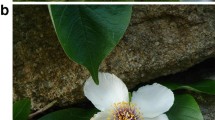Abstract
Horse chestnut is the common name for Aesculus hippocastanum. The family Hippocastanaceae contains about 15 species in two genera, Aesculus and Billia, and occurs in the North Temperate Zone. Of the 15 species, one is European, and the others are native to Eurasia and North America. The trees are dicots, characterized by large winter buds covered with resinous, sticky scales; opposite, palmately compound, 10–25 cm long leaves with 5–7 obovate leaflets; large clusters of attractive yellow, red or whitish irregular flowers of four or five petals; and bark that exfoliates in gray plates to show orange-brown inner bark. The fruits are leathery, three-valved capsules containing large, brown seeds (Fig. 1). Many members of the genus Aesculus,commonly called buckeyes, are popular ornamental and shade trees.
Access this chapter
Tax calculation will be finalised at checkout
Purchases are for personal use only
Preview
Unable to display preview. Download preview PDF.
Similar content being viewed by others
References
Abdelnour-Esquivel A, Mora A, Villalobos V (1992a) Cryopreservation of zygotic embryos of Musa acuminata (AA) and M. balbisiana ( BB ). Cryo Lett 13: 159–164
Abdelnour-Esquivel A, Villalobos V, Engelmann F (1992b) Cryopreservation of zygotic embryos of Coffea spp. Cryo Lett 13: 297–302
Andarajah K, Kott K, Beversdorf WD, McKersie BD (1991) Induction of desiccation tolerance in microspore-derived embryos of Brassica napus L. by thermal stress. Plant Sci 77: 119–123
Assy-Bah B, Engelmann F (1992) Cryopreservation of mature embryos of coconut (Cocus nucifera L.) and subsequent regeneration of plantlets. Cryo Lett 13: 117–126
Bajaj YPS (1995) Cryopreservation of plant cell, tissue and organ culture for the conservation of germplasm and biodiversity. In: Bajaj YPS (ed) Biotechnology in agriculture and forestry, vol 32. Cryopreservation of plant germplasm I. Springer, Berlin Heidelberg New York, pp 3–18
Brearley J, Henshaw GG, Davey C, Taylor NJ, Blakesley D (1995) Cryopreservation of Fraxinus excelsior L. zygotic embryos. Cryo Lett 16: 215–218
Collins GG, Nie X, Saltveit ME (1993) Heat shock increases chilling tolerance of mung bean hypocotyl tissue. Physiol Plant 89: 117–124
Dumet D, Engelmann F, Chabrillange N, Duval Y (1993) Cryopreservation of oil palm (Elaeis guineensis Jack.) somatic embryos involving a desiccation step. Plant Cell Rep 12: 352–355
Gamborg OL, Miller RA, Ojima K (1968) Nutrient requirements of suspension cultures of soybean root cells. Exp Cell Res 50: 151–158
Gamborg OL, Davies BP, Stahlhut RW (1983) Cell division and differentiation in protoplasts from cell cultures of Glycine species and leaf tissues of soybean. Plant Cell Rep 2: 213–215
Gonzalez-Benito ME, Perez C (1994) Cryopreservation of embryonic axes of two cultivars of hazelnut (Corylus avellana L). Cryo Lett 15: 41–46
Harrington HM, Alm DM (1988) Interaction of heat and salt stress in cultured tobacco cells. Plant Physiol 88: 618–625
Hatanaka T, Yasuda T, Tamaguchi T, Sakai A (1994) Direct regrowth of encapsulated somatic embryos of coffee (Coffea canephora) after cooling in liquid nitrogen. Cryo Lett 15: 47–52
Jennings P, Saltveit ME (1994) Temperature and chemical shocks induce chilling tolerance in germinating Cucumis sativus (Cv. Poinsett 76) seeds. Physiol Plant 91: 703–707
Jorgensen J (1990) Conservation of valuable gene resources by cryopreservation in some forest tree species. Plant Physiol 136: 373–376
Kaul SC, Obuchi K, Iwahashi H, Komatsu Y (1992) Cryoprotection provided by heat shock treatment in Saccharomyces cerevisiae. Cell Mol Biol 38: 135–143
Kendall EJ, Kartha KK, Qureshi JA, Chermak P (1993) Cryopreservation of immature spring wheat zygotic embryos using an abscisic acid pretreatment. Plant Cell Rep 12: 89–94
Kiss J, Heszky LE, Kiss E, Gyulai G (1992) High efficiency adventive embryogenesis on somatic embryos of anther, filament and immature proembryo origin in horse-chestnut (Aesculus hippocastanum L.) tissue culture. Plant Cell Tissue Org Cult 30: 59–64
Marin ML, Duran-Vila N (1988) Survival of somatic embryos and recovery of plants of sweet orange (Citrus sinensis L.) after immersion in liquid nitrogen. Plant Cell Tissue Org Cult 14: 51–57
Normah MN, Vengadasalam M (1992) Effects of moisture content on cryopreservation of Coffea and Vigna seeds and embryos. Cryo Lett 13: 199–208
Pence VC (1991) Cryopreservation of immature embryos of Theobroma cacao. Plant Cell Rep 10: 144–147
Reed BM (1993) Responses to ABA and cold acclimation are genotype dependent for cryopreserved blackberry and raspberry meristems. Cryobiology 30: 179–184
Reinhoud PJ, Schrijnemakers WM, van Iren F, Kijne W (1995) Vitrification and heat shock treatment improve cryopreservation of tobacco cell suspension compared to two step freezing. Plant Cell Tissue Org Cult 42: 261–267
Skowyra D, Georgopoulos C, Zylicz M (1990) The E. coli dnaK product, the hps homolog, can reactivate heat inactivated RNA polymerase in ATP hydrolysis manner. Cell 62: 939–944
Uragami A (1991) Cryopreservation of asparagus (Asparagus officinalis L.) cultured in vitro. Res Bull Hokkaido Natl Agric Exp Stn 156: 1–37
Wright JW (1976) Introduction to forest genetics. Academic Press, New York, 335 pp
Author information
Authors and Affiliations
Editor information
Editors and Affiliations
Rights and permissions
Copyright information
© 2002 Springer-Verlag Berlin Heidelberg
About this chapter
Cite this chapter
Jekkel, Z., Kiss, J., Gyulai, G., Kiss, E., Heszky, L.E. (2002). Cryopreservation of Somatic Embryos from Aesculus hippocastanum L. (Horse Chestnut). In: Towill, L.E., Bajaj, Y.P.S. (eds) Cryopreservation of Plant Germplasm II. Biotechnology in Agriculture and Forestry, vol 50. Springer, Berlin, Heidelberg. https://doi.org/10.1007/978-3-662-04674-6_14
Download citation
DOI: https://doi.org/10.1007/978-3-662-04674-6_14
Publisher Name: Springer, Berlin, Heidelberg
Print ISBN: 978-3-642-07502-5
Online ISBN: 978-3-662-04674-6
eBook Packages: Springer Book Archive




